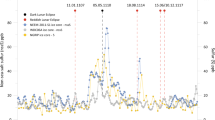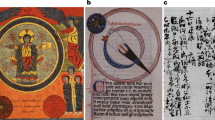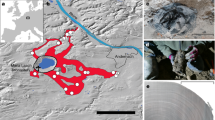Abstract
It has long been estabished that gas and fine ash from large equatorial explosive eruptions can spread globally, and that the sulphuric acid that is consequently produced in the stratosphere can cause a small, but statistically significant, cooling of global temperatures1,2. Central to revealing the ancient volcano–climate connection have been studies linking single eruptions to features of climate-proxy records such as found in ice-core3,4,5 and tree-ring6,7,8 chronologies. Such records also suggest that the known inventory of eruptions is incomplete, and that the climatic significance of unreported or poorly understood eruptions remains to be revealed. The AD 1600 eruption of Huaynaputina, in southern Peru, has been speculated to be one of the largest eruptions of the past 500 years; acidity spikes from Greenland and Antarctica ice3,4,5, tree-ring chronologies6,7,8, along with records of atmospheric perturbations in early seventeenth-century Europe and China9,10, implicate an eruption of similar or greater magnitude than that of Krakatau in 1883. Here we use tephra deposits to estimate the volume of the AD 1600 Huaynaputina eruption, revealing that it was indeed one of the largest eruptions in historic times. The chemical characteristics of the glass from juvenile tephra allow a firm cause–effect link to be established with glass from the Antarctic ice, and thus improve on estimates of the stratospheric loading of the eruption.
This is a preview of subscription content, access via your institution
Access options
Subscribe to this journal
Receive 51 print issues and online access
$199.00 per year
only $3.90 per issue
Buy this article
- Purchase on Springer Link
- Instant access to full article PDF
Prices may be subject to local taxes which are calculated during checkout


Similar content being viewed by others
References
Cadle, R. D., Kiang, C. S. & Louis, J. F. The global scale dispersion of the eruption clouds from major volcanic eruptions. J. Geophys. Res. 81, 3125 – 3132 (1976).
Mass, C. F. & Portman, D. A. Major volcanic eruptions and climate: a critical evaluation. J. Clim. 2, 566 – 593 (1989).
Hammer, C. U., Clausen, H. B. & Dansgaard, W. Greenland ice sheet evidence of post-glacial volcanism and its climatic impact. Nature 288, 230 – 235 (1980).
Zielinski, G. A. Stratospheric loading and optical depth estimates of explosive volcanism over the last 2100 years derived from the GISP2 Greenland ice core. J. Geophys. Res. 100, 20937 – 20955 (1995).
Delmas, R. J., Kirchner, S., Palais, J. M. & Petit, J. R. 1000 years of explosive volcanism recorded at the South Pole. Tellus B44, 335 – 350 (1992).
LaMarche, V. C. & Hirschboeck, K. K. Frost rings in trees as records of major volcanic eruptions. Nature 307, 121 – 126 (1984).
Jones, P. D., Briffa, K. R. & Schweingrubeer, F. H. Tree-ring evidence of the widespread effects of explosive volcanic eruptions. Geophys. Res. Lett. 22, 1333 – 1336 (1995).
Briffa, K. R., Jones, P. D., Schweingruber, F. H. & Osborn, T. J. Influence of volcanic eruptions on Northern Hemisphere summer temperatures over 600 years. Nature 393, 450 – 455 (1998).
Lamb, H. H. Volcanic dust in the atmosphere; with a chronology and assessment of its meteorological significance. Phil. Trans. R. Soc. Lond. A 266, 425 – 533 (1970).
Scuderi, L. A. Oriental sunspot observations and volcanism. Q. J. R. Astron. Soc. 31, 109 – 120 (1990).
de Silva, S. L., Alzueta, J. & Salas, G. in Volcanic Disasters in Human Antiquity(eds Heiken, G. & McCoy, F.) (Geol. Soc. Am. Spec. Paper, in the press).
Newhall, C. & Self, S. The volcanic explosivity index (VEI): an estimate of explosive magnitude for historical volcanism. J. Geophys. Res. 87, 1231 – 1238 (1982).
Simkin, T. & Fiske, R. Krakatau 1883; the Volcanic Eruption and its Effects(Smithsonian Inst., Washington DC, 1983).
Hildreth, W. New perspectives on the eruption of 1912 Valley of Ten Thousand Smokes, Katmai National Park, Alaska. Bull. Volcanol. 49, 680 – 693 (1987).
Scott, W. E. et al. in Fire Mud: Eruptions and Lahars of Mount Pinatubo, Philippines(eds Newhall, C. G. & Punongbayan, R. S.) 545 – 571 (Univ. Washington Press, Seattle, 1996).
Palais, J. M., Kirchner, S. & Delmas, R. J. Identification of some global volcanic horizons by major element analysis of fine ash in Antarctic ice. Ann. Glaciol. 14, 216 – 220 (1990).
Pyle, D. M. On the ‘climate effectiveness’ of volcanic eruptions. Quat. Res. 37, 125 – 129 (1992).
McCormick, M. P., Thomason, L. W. & Trepte, C. R. Atmospheric effects of the Mt Pinatubo eruption. Nature 373, 399 – 404 (1995).
Zielinski, G. A. et al. Climatic impact of the AD 1783 eruption of Asama (Japan) was minimal: evidence from the GISP2 ice core. Geophys. Res. Lett. 21, 2365 – 2368 (1994).
Zielinski, G. A. et al. Assessment of the record of the 1982 El Chichón eruption as preserved in Greenland snow. J. Geophys. Res. 102, 30031 – 30045 (1997).
Clausen, H. B. et al. Acomparison of the volcanic records over the past 4000 years from the Greenland ice core project and Dye 3 Greenland ice cores. J. Geophys. Res. 102, 26707 – 26723 (1997).
Cole-Dai, J., Mosley-Thompson, E. & Thompson, L. Annually resolved southern hemisphere volcanic history from two Antarctic ice cores. J. Geophys. Res. 102, 16761 – 16771 (1997).
Briffa, K. R. et al. Fennoscandian summers from AD 500: temperature changes on short and long timescales. Clim. Dyn. 7, 111 – 119 (1992).
Briffa, K. R., Jones, P. D. & Schweingrubeer, F. H. Tree-ring density reconstructions of summer temperature patterns across western North America since 1600. J. Clim. 5, 735 – 754 (1992).
Scuderi, L. A. Tree ring evidence for climatically effective volcanic eruptions. Quat. Res. 34, 67 – 86 (1990).
Filion, L., Payette, S., Gauthier, L. & Boutin, Y. Light rings in subarctic conifers as a dendrochronological tool. Quat. Res. 26, 272 – 279 (1986).
Anonymous Annáler 6 493 – 494 (1400–1800).
Frisch, C. (ed.) Joannis Kepleris Astronomi Opera Omnia 2/3(1856–1871).
Keen, R. A. Volcanic aerosols and lunar eclipses. Science 222, 1011 – 1013 (1983).
Simkin, T. & Siebert, L. Volcanoes of the World 2nd edn(Geoscience Press, Tucson, 1994).
Pyle, D. M. The thickness, volume, and grainsize of trephra fall deposits. Bull. Volcanol. 51, 1 – 15 (1989); Assessment of the minimum volume of tephra fall deposits. J. Volcanol. Geotherm. Res. 69, 379 – 382 (1995).
Fierstein, J. & Nathenson, M. Another look at the calculation of fallout tephra volume. Bull. Volcanol. 54, 156 – 167 (1991).
Acknowledgements
We thank G. Salas, P. Francis, S. Self and the Instituto Geofisico de Peru, particularly the late M. Chang, for their collaboration on this project; P. Mayewski, L. D. Meeker, S. Whitlow and M. Twickler for their work in producing the initial sulphate time series of the GISP2 ice core; M. Germani and J. Palais for their help with the GISP2 tephra studies; J. Fierstein, M. Nathenson and N. Adams for help and discussions about the volume estimates; the members of the GISP2 community for work in developing the chronology of the core; and the Science Management Office, Polar Ice Coring Office and 109th Air National Guard for logistical support. Funding for this work has come from Indiana State University, and the National Science Foundation Petrology and Geochemistry Program, Office of Polar Programs (GISP2 work), and Atmospheric Sciences Program. The manuscript has benefited considerably from thorough reviews by D. Pyle and P. Allard.
Author information
Authors and Affiliations
Corresponding author
Rights and permissions
About this article
Cite this article
de Silva, S., Zielinski, G. Global influence of the AD 1600 eruption of Huaynaputina, Peru. Nature 393, 455–458 (1998). https://doi.org/10.1038/30948
Received:
Accepted:
Issue Date:
DOI: https://doi.org/10.1038/30948
This article is cited by
-
River freeze-up date anomalies during the sixteenth to nineteenth centuries in southern Northeast China reconstructed from the Korean Envoys Yanxing Book
Climatic Change (2024)
-
Climatic and societal impacts of a “forgotten” cluster of volcanic eruptions in 1108-1110 CE
Scientific Reports (2020)
-
Two-mica rhyolitic tephra in the East Pisco Basin (Peru): new age and dispersion constraints for the eruptions of the Eastern Cordillera of Central Andes
Bulletin of Volcanology (2020)
-
Century-scale temperature variability and onset of industrial-era warming in the Eastern Tibetan Plateau
Climate Dynamics (2019)
-
Climate response to the Samalas volcanic eruption in 1257 revealed by proxy records
Nature Geoscience (2017)
Comments
By submitting a comment you agree to abide by our Terms and Community Guidelines. If you find something abusive or that does not comply with our terms or guidelines please flag it as inappropriate.



